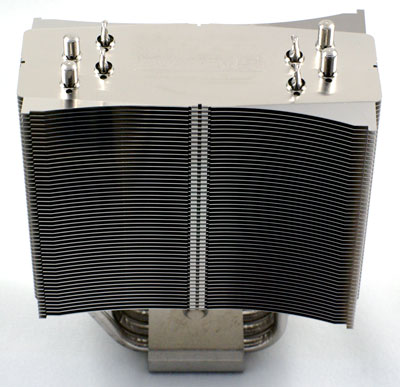Cooler Master GeminII: Performer or Poser?
by Wesley Fink on April 30, 2007 2:00 AM EST- Posted in
- Cases/Cooling/PSUs
If looks equals performance then the Cooler Master GeminII will certainly top our performance charts. The GeminII has stirred the imagination of our readers like no other new cooler that has been introduced. This is primarily the result of the unique design of this heatpipe tower that tries to address issues that some fear remain with current heatpipe tower designs.

The top-performing air tower designs we have tested, like the Thermalright Ultra 120 pictured above, have the heatpipes rising from the base that contacts the CPU, with horizontal cooling fins. The 120mm cooling fan blows from the side of this plate stack, directing air to the rear of the case. Performance tests have shown this to be a very effective air cooler design, but some still worry that motherboard components cannot be cooled as well with this configuration as they might be with a traditional down-facing fan.

Cooler Master's GeminII switches things around by moving six heatpipes to a cantilevered top array cooler with vertical fans attached to the pipes. In the process the Gemini II creates a massive top-mounting space that can accommodate up to two 120mm down-facing fans.
Cooler Master emphasizes that the idea behind the GeminII is efficient CPU cooling with good cooling for motherboard components provided by the fans blowing down. It all looks and sounds logical enough, but looks and logic have proven off-target before in our testing. We were very anxious to run the Gemini II through our cooling test bed to see if it improved on the performance of the best air coolers we have tested in our labs.

The top-performing air tower designs we have tested, like the Thermalright Ultra 120 pictured above, have the heatpipes rising from the base that contacts the CPU, with horizontal cooling fins. The 120mm cooling fan blows from the side of this plate stack, directing air to the rear of the case. Performance tests have shown this to be a very effective air cooler design, but some still worry that motherboard components cannot be cooled as well with this configuration as they might be with a traditional down-facing fan.

Cooler Master's GeminII switches things around by moving six heatpipes to a cantilevered top array cooler with vertical fans attached to the pipes. In the process the Gemini II creates a massive top-mounting space that can accommodate up to two 120mm down-facing fans.
Cooler Master emphasizes that the idea behind the GeminII is efficient CPU cooling with good cooling for motherboard components provided by the fans blowing down. It all looks and sounds logical enough, but looks and logic have proven off-target before in our testing. We were very anxious to run the Gemini II through our cooling test bed to see if it improved on the performance of the best air coolers we have tested in our labs.










44 Comments
View All Comments
Martimus - Monday, April 30, 2007 - link
It seems that turning the fans around would make more sense, considering that the airflow through the fins would be the same, but it wouldn't be blowing the hot air back onto the chip like it does in the configuration you show.pannivas - Monday, April 30, 2007 - link
This is a good cooler for an HTPC system. Because it performed OK in cooling (no OC), it's short and can fit in most HTPC cases (106.5mm including fans), and it can also be very silent by using one or two Noctua NF-S12 fans.thanks for the review
Jedi2155 - Monday, April 30, 2007 - link
Wow!Have you been running that CPU @ 1.5875 volts for 24/7 usage or do you just put it that high during your heatsink testing? Is it safe?
I also have a 680i, and have trouble getting 3.6 GHz stable with around 1.55 volts, but I'm afraid of putting it higher than that on my Tuniq 120 as I plan on keeping my CPU for a few years.
Jodiuh - Monday, April 30, 2007 - link
Thanks guys, looks like I'll hang w/ the Tuniq + Scythe SFLEX E for a bit longer and keep cooling the RAM/NB w/ a "wall" of 120's.